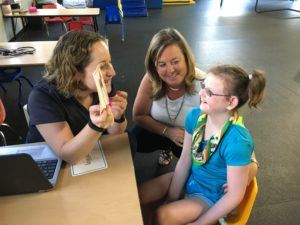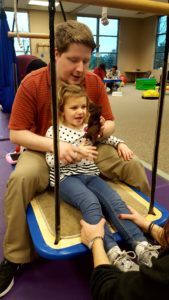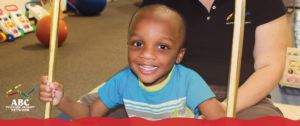Speech
Frustration. We all experience moments of frustration, but the way in which we each handle our frustrations is very different and also very important. When children experience moments of frustrations it may include behaviors such as yelling, screaming, crying, hitting, etc. 
Does this sound familiar? Parents oftentimes feel overwhelmed and frustrated when their child is unable to communicate what is wrong or frustrating them and doing these undesirable behaviors. These frustrations and behaviors may actually be happening because your child is unable to effectively communicate to you what is wrong or what they want.
Let’s say you wake up in the middle of the night to your child crying and screaming. You are able to calm your child down, but they are still not able to tell you what is wrong with them. You know that something is wrong with your child, but you do not know the reason because your child cannot tell you; did they hit their head, have a bad dream, or are they sick? Only your child knows what is going on, but why won’t they tell you?
This type of situation can be both scary and frustrating for parents, but what can you do to help your child? Firstly, realize that children who have a difficult time communicating their wants/needs/ideas are more likely to become frustrated because their needs are not being met or they are not being understood. It is not necessarily that the child is trying to be bad, but that the child is so frustrated at not being able to communicate effectively that they communicate in the way that works for them which is the unwanted behavior. This decrease in communication and increase in frustration go hand-in-hand with children “acting out” or doing an unwanted behavior. When a child can effectively communicate their wants/needs/ideas, frustration and unwanted behaviors are more likely to decrease if the problem was an inability to communicate.
Secondly, make sure your child is on the right track developmentally with their speech and language.
Here are a few things to be on the lookout for:
· By 12 months of age, a child should begin making single words such as Mama, Dada, Doggie, Ball, Bye-bye, Hi, etc.
· By 24 months of age, a child should be using 2-word phrases frequently such as “bye-bye daddy”, “my ball”, “go potty” etc. and be able to identify basic body parts
· By 24 months of age, you should be able to understand approximately 50-75% of what a child is saying; you should be able to understand about half of what a child says.
· By 36 months of age, a child should be able to answer basic “wh” questions (e.g., “what’s your name”, “where does it hurt”, etc.) and be approximately 75% or more intelligible.
For more information on typical speech and language development in children up to six years of age, try our Interactive Screening Tool at checklist.abcpediatrictherapy.com.
If you notice that your child having a difficult time communicating, here are a few tips to try at home first:
· Use pictures or symbols that your child is familiar with. Have your child point to the picture or hand you the picture of what they are trying to communicate. Tell your child what you think their intention is and complete the task. For example, if your child points to the picture of the potty, say “Oh, you need to go potty. Let’s got to the potty” and take your child to the bathroom.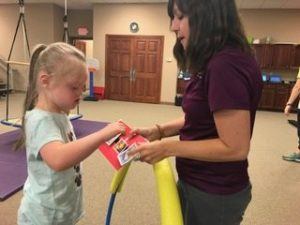
· Use basic hand signs and gestures with your child to help meet their basic wants/needs. Beginning signs to use with your child may include “more” and “all done.”
· Label items and objects with your child and talk about them.
· Incorporate music and play into your child’s daily activities.
· Talk and play with your child often. Children learn best through play and with other people face to face.
If your child’s communication skills do not begin to show improvement within a few weeks, it would be recommended to schedule a speech and language evaluation with your local Speech Therapist. For more information on speech and language development and speech therapy services, visit https://www.abcpediatrictherapy.com
Read More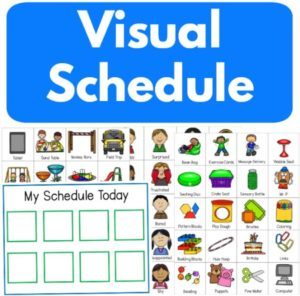 A visual schedule is something that allows children to see their day or activity in a more organized manner. These work great for kids diagnosed on the Autism Spectrum, ADHD, or anyone for that matter! The implementation of visual supports and schedules provides structure, and allows children to know what is expected of them, such as answering “what work” is expected of them and “how much work” is expected of them. This helps to alleviate stress when it comes to transitioning and allows children to see what is coming next. It allows our kids to feel better prepared and better organized, and may help to reduce behavioral problems.
A visual schedule is something that allows children to see their day or activity in a more organized manner. These work great for kids diagnosed on the Autism Spectrum, ADHD, or anyone for that matter! The implementation of visual supports and schedules provides structure, and allows children to know what is expected of them, such as answering “what work” is expected of them and “how much work” is expected of them. This helps to alleviate stress when it comes to transitioning and allows children to see what is coming next. It allows our kids to feel better prepared and better organized, and may help to reduce behavioral problems.
A visual schedule can be used for almost anything, from planning out an entire day to planning out a specific event. These work great for planning specific daily events-such as a morning or bedtime routine. A visual schedule can be made by using PECS pictures to handwritten or hand-drawn pictures! Visual supports also work in this way. Visual supports can be anything from a Venn diagram (for those school-aged kids working on language expansion), to a visual timer for children to see when time to be spent on a certain activity is up, to any other aid that our kids can see!
I like to start off therapy sessions by creating a visual schedule with my kids. I like to give them the choice of the reward activity (bubbles, jumping, bike, etc.) and I pick the structured activity. For example, if we are going to read a book (I will generally pull two and allow the child to choose-if possible), I will tell them first we are reading a book, and then we will do the desired activity of their choice. This way, it creates a structured environment that is still fun, in which they understand what will be expected of them and what the reward can be for our 30 minute session together.
It is important to note that, as is true with any treatment, there is no “one size fits all” approach! One child may need a very detailed visual schedule, while the next may need just a general layout of the day. These can be implemented in ANY environment-home, school, therapy, you name it! There are many examples of these on the Internet, or just talk to your therapist if you would like any more information about the topic!
Written by Nicole Dupont, M.A., CFY-SLP
Read MoreEvery child has behaviors. It’s the nature of being a child! I am the mother of two small children. I have been a pediatric speech-language pathologist for over six years. So you can imagine how many behaviors I have seen! Some behaviors are typical for all children. They don’t always listen the first time you tell them something, and sometimes there are tears for not getting their way. However, some behaviors are not acceptable, such as aggressive behaviors or consistent defiance. These types of behaviors could include frequent/excessive crying, hitting, kicking, biting, scratching, frequently refusing to follow directions or other unsafe behaviors such as running/climbing. So why, you think to yourself, does my child behave this way? There is always a reason behind a behavior. Your child may be seeking your attention. He/she may be seeking physical movement, a sensory need. Your child may need a more structured environment. From my perspective as a speech-language pathologist, your child may have functional communication difficulties.
Communication is key piece of a functional life. We may not all communicate in the same way, but we all communicate one way or the other. When a child is unable to functionally communicate, their world is one big uphill battle. Communication is our way of knowing what a child wants, needs, thinks and feels. So ask yourself, how does my child get want he/she wants or needs? Talking? Pointing? Get it him/herself? Crying? As parents of young children, we are caring and providing for them on a daily basis. I hear parents frequently say, “I know what he wants; I get it for him.” As parents, we know our children better than anyone else in the whole world. So much of the time, it’s true; we do know what they need or want. But what about those times when we don’t know? Those are the times when we scratch our heads. As this begins to happen more often, the child becomes frustrated, and the behaviors can start to escalate or become more frequent. After a while, the parent is frustrated and doesn’t know what to do. We have to address the child’s communication challenges.
Try these:
1. Model the words for the child. Keep it simple. “More milk.” “Cracker please.” “Help me.” Have the child attempt to repeat the words. Attempt is the key word here. Maybe your child doesn’t have the speech sounds to say certain words perfectly. That’s ok. If you say “more milk” and your child says “muh muh,” praise him and say, “Oh thank you for using your words. Here is your milk.”
2. Give choices. You don’t know what she wants. Choose a few things in the general area of where she’s pointing. Ask if she wants one of those. If so, go back to step 1 and model the words. Praise the communication attempt.
3. Show me. Some children are quick to take your hand and lead you to what they want. Once you figure it out, go back to step 1 and model the words. Praise the communication attempt.
**Be a teacher. We as parents are our child’s first teachers. In the first 3-4 years of life, they learn just about everything from you. But, don’t fear! You don’t have to be a certified teacher or therapist to teach your children well. One thing we can all do more of is talk to our children. Children are like sponges. They tend to soak up whatever is thrown their way!
• Share books together every day. Grab a few free ones from the library. Read the story. But don’t stop there. Forget the words and tell the story just by looking at the pictures. Describe what you see. If your child says a word or two, expand on it. “Ball!” “Oh yes, the boy is playing ball in the grass.” “Doggie!” “I see! The doggie is eating his food.” You’re teaching your child vocabulary and sentence structure.
• Ask questions. If you’re child can’t answer the questions, that’s ok. Model the answers for them. “What are you playing with?” “Car!” “What does the car do? Drive? Drive car fast!” “Where does the car drive? On the road!” “Who rides in the car? Mom, brother, sister” “Where do we go in the car? Grocery store! School! Work!”
• Tell what you’re doing. As parents, it seems there is always something that has to be done! Dishes, laundry, yard work! The list goes on and on. Let your child be a helper! “I’m using warm water and soap to clean this plate. Then I’ll use a towel to dry it off.” “Oh, thank you for putting the clean clothes in the basket.” Just by narrating your actions, you’re teaching your child tons of vocabulary.
***As always, consult your doctor. Pediatricians try to ask as many questions as possible regarding your child’s development when you visit. Often, they ask about the child’s communication. If they do, give a detailed description of how your child communicates. If they don’t ask, bring it up! Talk about how your child communicates and ask if it’s age-appropriate. Don’t be afraid to talk openly and honestly with your doctor about this or any issue. It’s how you and your doctor can work together to provide the best care for your child. Your doctor can help you find the people and resources your child needs. If your child has communication difficulties, speech-language therapy can help you and your child communicate and reduce or even eliminate some behaviors.
Just remember, help is out there for you.
Katy Cavanaugh, MS, CCC-SLP 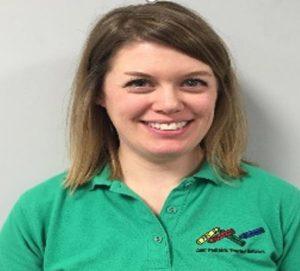
ABC Pediatric Therapy Network
[email protected]
 Skip to content
Skip to content
